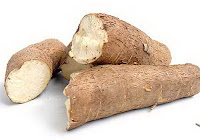Agriculture | Cassava | Cassava also called yuca or manioc, is a tuberous, woody, shruby perennial plant, Manihot esculenta, of the Euphorbiaceae (spurge family), characterized by palmately lobed leaves, inconspicuous flowers, and a large, starchy, tuberous root with a tough, papery brown bark and white to yellow flesh.The name cassava (Manihot esculenta) also is used for this tuber, which is a major source of carbohydrates and is a dietary staple in many tropical nations. This plant and root also are known as yuca, manioc, and mandioca.
While native to South America, cassava (Manihot esculenta) now is extensively cultivated as an annual crop in many tropical and subtropical regions of the world, including Africa, India, and Indonesia, with Africa its largest center of production.This is a prolific crop that can grow in poor soil and is drought tolerant. It is the one of the most important food plants in the tropics and the third largest source of carbohydrates for human food in the world.
The roots and leaves contain cyanogenic glucosides, which offer a protection against some herbivores, but also make the plant toxic to humans if consumed without prior treatment, such as leaching and drying. In particular, the varieties known as "bitter cassava" contain significant amounts of cyanide, with the "sweet cassava" less toxic. It is a unique aspect of human beings to be able to process toxic plants into a form that makes them edible.
Cassava (Manihot esculenta) is the source of flour called tapioca, as well as is used for breads, and alcoholic beverages. The leaves also can be treated and eaten. However, cassava is a poor source of protein and reliance on cassava (Manihot esculenta) as a staple food is associated with the disease kwashiorkor.
Manihot esculenta, or cassava, is a slightly woody, generally shruby plant that typically grows from one to three meters (3-10 feet) in height (Katz and Weaver 2003). The leaves are nearly palmate (fan- or hand-shaped) and dark green in color. There are over 5,000 varieties of cassava known, each with distinct qualities, and they range from low herbs to shrubs with many branches, to unbranched trees.
The cassava (Manihot esculenta) root is long and tapered, with a firm homogeneous flesh encased in a detachable rind, about 1 millimeter thick, and rough and brown on the outside, just like a potato. Commercial varieties can be 5 to 10 centimeters in diameter at the top, and 50 to 80 centimeters long. A woody cordon runs along the root's axis. The flesh can be chalk-white or yellowish.
Although there are many varieties of cassava, there are two main varieties, sweet and bitter. These are classified on the basis of how toxic are the levels of cyanogenic glucosides.
The Cassava (Manihot esculenta) plant gives the highest yield of food energy per cultivated area per day among crop plants, except possibly for sugarcane. - CASSAVA - AGRICULTURE
While native to South America, cassava (Manihot esculenta) now is extensively cultivated as an annual crop in many tropical and subtropical regions of the world, including Africa, India, and Indonesia, with Africa its largest center of production.This is a prolific crop that can grow in poor soil and is drought tolerant. It is the one of the most important food plants in the tropics and the third largest source of carbohydrates for human food in the world.
The roots and leaves contain cyanogenic glucosides, which offer a protection against some herbivores, but also make the plant toxic to humans if consumed without prior treatment, such as leaching and drying. In particular, the varieties known as "bitter cassava" contain significant amounts of cyanide, with the "sweet cassava" less toxic. It is a unique aspect of human beings to be able to process toxic plants into a form that makes them edible.
Cassava (Manihot esculenta) is the source of flour called tapioca, as well as is used for breads, and alcoholic beverages. The leaves also can be treated and eaten. However, cassava is a poor source of protein and reliance on cassava (Manihot esculenta) as a staple food is associated with the disease kwashiorkor.
Manihot esculenta, or cassava, is a slightly woody, generally shruby plant that typically grows from one to three meters (3-10 feet) in height (Katz and Weaver 2003). The leaves are nearly palmate (fan- or hand-shaped) and dark green in color. There are over 5,000 varieties of cassava known, each with distinct qualities, and they range from low herbs to shrubs with many branches, to unbranched trees.
The cassava (Manihot esculenta) root is long and tapered, with a firm homogeneous flesh encased in a detachable rind, about 1 millimeter thick, and rough and brown on the outside, just like a potato. Commercial varieties can be 5 to 10 centimeters in diameter at the top, and 50 to 80 centimeters long. A woody cordon runs along the root's axis. The flesh can be chalk-white or yellowish.
Although there are many varieties of cassava, there are two main varieties, sweet and bitter. These are classified on the basis of how toxic are the levels of cyanogenic glucosides.
The Cassava (Manihot esculenta) plant gives the highest yield of food energy per cultivated area per day among crop plants, except possibly for sugarcane. - CASSAVA - AGRICULTURE








This comment has been removed by the author.
ReplyDelete